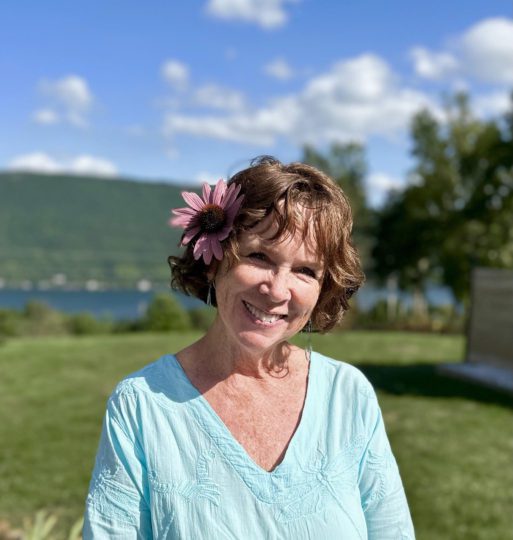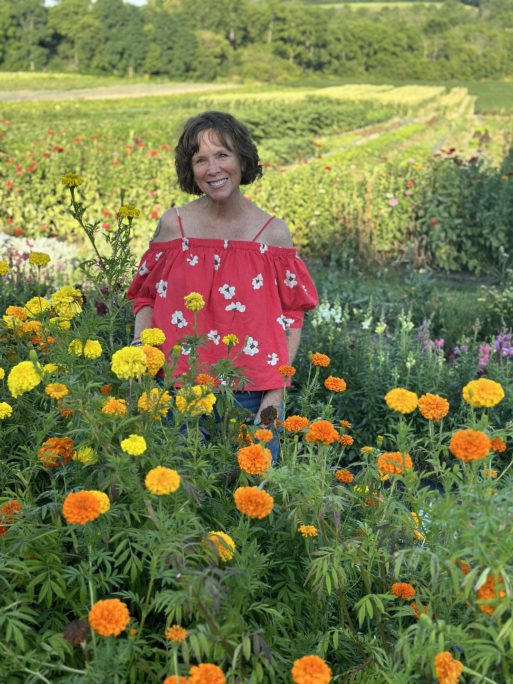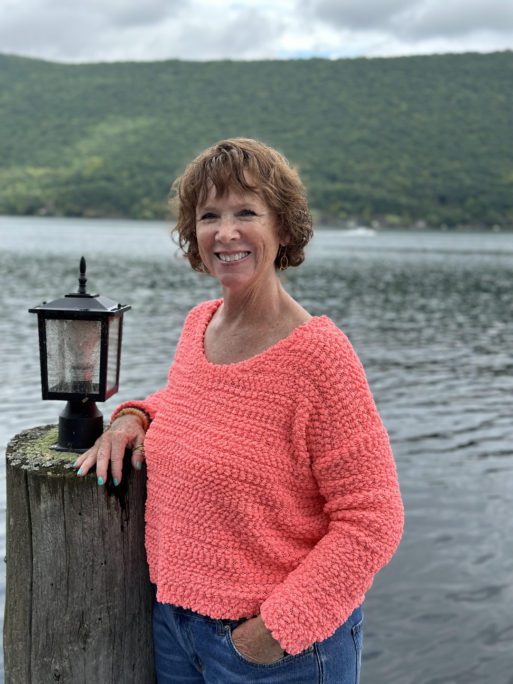
Gabrielle Elise Jimenez overcame a difficult upbringing to find joy — and she hopes you will too.
Hospice nurse and end-of-life doula Gabrielle Elise Jimenez has not had an easy life. During a recent Zoom class on ritual and forgiveness, she shared several more-than-challenging things to forgive: A father who was physically and emotionally abusive, a family friend who sexually assaulted her at a young age and a partner whose infidelity caused a pregnancy. “I want people to know that I’m human, and can appreciate what they’ve been through, and that they’re not alone,” she said. “It’s really hard to say these things, but it’s also incredibly freeing. What if I say it, and one person says, ‘Wow, that happened to me, too. And maybe I can move on from here.’”
Despite dropping out of high school after being repeatedly told by her father that she was “stupid,” Jimenez proved him wrong by entering nursing school in her 40s. She later continued on to become a hospice nurse, end-of-life doula and conscious dying educator. Now based in Redwood City, California, she offers classes and workshops through her website: The Hospice Heart.
Editors Note: This interview has been edited for length and clarity.
What inspired you to begin working as a hospice nurse and end-of-life doula?
For most of my life, I was managing commercial real estate and working as a safety coordinator for OSHA. But then, the husband of one of my best friends was dying of prostate cancer. I was in between contracts at the time, so when she asked if I would help take care of him so she could go to work, I did. I went to Las Vegas, where they lived, and I stayed in a twin bed next to his twin bed. I helped with meals. I helped with bathing. But mostly we just talked about life and what it felt like for this vibrant, healthy man – he was a movie director for Playboy and HBO – to suddenly get this illness. His whole life had changed. So I witnessed that. And I witnessed the hospice people coming in and out; taking care of him. And then he died. I’d had so much experience with death in my life, but was never truly present for it.
After he died, I decided I wanted to be a caregiver, which was a quarter of the pay of what I would have received at my normal job. So I went to an adult school in my town, got my certificate to be a home health aide and a CNA, and then I studied acute care and gerontology care. I had to move out of my house and rent a room from a friend because I couldn’t afford it, but I knew this was what I wanted to do. I started taking care of a couple who were both in their 80s, and I realized that they were not getting the care I thought they deserved – their medicines weren’t being managed and their decline wasn’t really being observed. Watching these elderly folks not get cared for well, not have autonomy, and not be respected made me decide to become a hospice nurse. I got accepted into a private program and passed all my prerequisites. And then they wanted my diploma, which I didn’t have because I’d dropped out of school. So I went back to the school where I got my CNA and they tutored me to get my GED.
You identify yourself as a conscious dying educator. What does conscious dying mean to you?
When I became an end-of-life doula, I received a certificate to be a conscious dying educator. What that means on paper is that I can teach others how to be doulas. But I had to really think about what conscious dying means, and to me, it means a sense of awareness physically, emotionally, spiritually, mentally – how someone is experiencing their own death. And it also means the awareness of their wishes being honored, or their care being provided in a beautiful and compassionate way. To me, being a conscious dying educator means helping to educate those who want to work in this field to come from a very heart-centered space and provide care that is solely based on that human being’s needs. Not all human beings, that human being, because they’re unique and individual.
How has being an end-of-life doula complemented your nursing work?
I wanted to be able to meet patients in my nursing role in a deeper, more powerful way. I think it started when working with patients receiving Medical Aid in Dying (MAID) because that’s so intimate and personal, and I wanted to be able to truly tap into what was felt, not just with the patient but with the family. It’s not just about the person in the bed, it’s about the people at the bedside, too. How can we offer them both the kind of care that encourages a soft landing, and a gentler, more graceful grief journey? The doula training really emphasized that. It reminded me to slow down and to be more present – and what presence actually means.

Jimenez in a field of flowers.
You place a strong emphasis in your work on ritual and ceremony. Why are these important to you?
It started when my dad died. He’d been sick for some time. One day I dropped him off at home, he asked me to stay for lunch, but I had to be somewhere. I called him later a couple of times, suggesting that we have lunch at another time, but he didn’t pick up his phone. It turned out that he’d died and had never received my messages. That’s when ritual started for me – when I realized that there were things I still had to say. I lit a candle and I said everything that I needed to say. Then, I blew it out, and I watched the smoke carry those words away.
Something similar happened with my older sister Laura, who died when I was at the very end of nursing school. She lived about 2-3 hours away and told me not to come be with her – she said that I was where I needed to be. I regret that. She was my closest family member, more so than my parents – she was my everything. And I needed her to know, so I did a ritual for her as well, hoping that she heard me and knew that I wanted to be with her and that I was sorry. I cried and I cried. I was so sad and so angry that I wasn’t there. And then I felt peace, because I knew in my heart that she heard me. That’s how the rituals make me feel – like I’m heard.
Then came COVID and I was with so many patients who couldn’t be with their family members. I held phones up to ears – there I was, all covered in PPE, and I didn’t understand why their family members couldn’t do the same. We did that wrong. I think the grief of those families is worse because they didn’t get to say goodbye, they didn’t get closure. They have an ache in their chest because they feel that they abandoned the person they loved the most. I had this need to bring them some peace, so I created rituals for the people that couldn’t say goodbye.
Later, it became more about connecting people at the bedside if they were struggling – especially siblings, or people experiencing the death differently from one another. I would create rituals to try to find a way to bring them together, because I believe that if the landing is softer, and the energy is changed at the bedside, then the grief journey can be softer. It allows a safe platform for those things to be said.
What do you do, or what can others do, to create a safe space?
I have these five core principles that I follow very frequently: Listening – not to fix, but to hear and validate their words; holding space; being present; showing up; and meeting them where they are. When you truly listen to someone – you look them in the eyes, and they know that they’ve been heard, they feel safe, but more than that, they trust you. I take their words for exactly what they are, which is a gift, and it’s sacred – I don’t take them lightly. If I let them talk, and I don’t look away, and I don’t get distracted, then they’re more likely to share their vulnerabilities, their fear, and their curiosities. Even their uncertainties – you know, all of that is intertwined around death and dying. People have stuff they want to say, they just don’t always have people they can say it to. I want to be that person.
For me, showing up is about being on time – don’t be late. Time takes on a whole new meaning when you have less of it left, and when you’re late for someone who is dying, that says their time doesn’t matter.
The most important one is to meet them where they are, not where you want them to be – it’s not about you. This is a business where it can be very easy to become selfish. It’s easy to make it about you, or how you feel, or how you’ve been there too. But it’s not about you, and we have to make sure they know that.
Are there any moments that come to mind when using ritual and ceremony with a client that were particularly powerful?
There are two stories I’ve written about on my blog that are really about honoring the moment – one is called “I Will Say Farewell, Good Man,” which is about MAID, but also about the ritual of saying goodbye. There’s another one called “The Never-Ending Box of Tissue.” And there’s “The Joy Counter,” which is about a patient with glioblastoma who had a ritual in which he used a movie clicker to count his joys.
I think my favorite story involving a ritual, and I’ll change some identifying details, is about a boyfriend and girlfriend, both in their 50s. He’d been married before and had two kids, and he was so deeply loved. On his deathbed, the ex-wife, the current girlfriend, the kids and all his friends were present. It was the first and only time I’ve ever seen an entire roomful of people on the same page – as far as what he needed, what each other needed, respecting one another’s space.
One ritual I do often is my embroidery ritual. Each person gets a piece of embroidery thread that’s about 16 inches long, cut in half – usually different colors. The idea is that you have a private moment with the person in the bed, and you tie one of the strings on their left wrist with four knots. For each knot, you share something you want to send them off with – a wish, a prayer, a memory, a goodbye. Then, the people in the room help each other tie the remaining strands on their left wrists with four knots, each representing something to give them peace, courage, and strength during their grief journey. While the string is on, you can touch it, and it’s your connection to them – much like a rosary bead, it brings comfort. And then when it falls off, that’s the message to let you know that they made it safely to wherever they’ve gone, that they’re free of pain and suffering. In this particular case, with this family, I’d provided them with about 15 strings, because there were so many people. Then, they actually went out and bought more embroidery thread because more people wanted to participate. On the day he died, he had some 25 strings on his wrist.
You mentioned some personal rituals in your workshop, such as the candle ritual, and making a mandala out of things collected in nature. Are there any other small, personal rituals that you do?
The patient in my story about the joy counter gave me one as well – it was just a movie clicker. I kept it in my scrubs pocket for weeks, and I would click my joys. Now I just keep it on my shelf of special things, but I mentally click the joy counter as a reminder to find joy every day, in the smallest of things. It’s a very consistent ritual for me – I count my joys. He taught me that.
What are some of the things that people struggle with most at the end of their lives, or when facing the death of a loved one?
The biggest is regret – on both sides. People who are dying commonly feel they’ve wasted time. No-one ever says, “I wish I worked more.” Another thing they’ve taught me is just how fragile and precious time is, and life. It’s not an illness necessarily that will take you, and we can’t predict that. They talk most about how much time was wasted. They wish they’d done more, they wish they’d said more.
One other thing that’s really common is regret around the last words said to someone before they died. Maybe it was “I hate you,” because they’d had some big argument, and they can’t take that back. People wish they had the chance to have a do-over, but there is no do-over. We don’t realize that until it’s too late.

Rather than drowning in regrets, Jimenez chooses to let things go.
I guess that’s when ritual is so important – to say those words.
Yes, and it’s also important to remind people that those who are dying can hear you. When my brother died, we hadn’t spoken in three years because of something he’d done to me and my children. But when I was sitting at his bedside and he was unconscious, I kept thinking: “Why did I hold onto that grudge for so long? Why didn’t I reach out to him? Why is anger so much more important than relationship?” And I apologized to him for that. Later, he woke up before he died, and he said, “I’m sorry, too.” He’d heard me. So for people at the bedside, I always say, “There’s no time like right now. Say you’re sorry. Offer forgiveness. Ask for forgiveness. Tell them everything you’re feeling, because that is what they will hear.”
It sounds like even after people die, you encourage them to do that.
Absolutely. I think that when someone takes their last breath, their physical body has shut down but their energy is still in the room – that person is still there. Even if it’s just in our hearts, I believe that they’re still there. And I want people to have permission to say whatever they need to say, and to feel whatever they need to feel. We don’t get to tell someone what they need to go through when that happens.
You mentioned regrets and forgiveness. Why is forgiveness so hard?
We’re riddled with guilt, and it’s really hard to admit when you’ve done or said something wrong. People are afraid to face their vulnerabilities, or their wrongdoings, or the parts of them they’re embarrassed of, or insecure about. You have to face them, make peace with them and let them go. We weren’t taught that. We were taught to keep it quiet, to not admit that you might fail, to not admit that we might be human.
What about when you’re trying to forgive somebody else? Do you think it’s necessary to voice the harm that was done?
I don’t think you have to face the person in order to forgive them. Because you’re not forgiving them for what they did, you’re saying, “I’m forgiving the weight of it all. This is your weight to carry. I hope you don’t, because it’s heavy, but I’m not carrying it anymore.” I don’t think you have to say something to them unless you want to resolve and repair. In my case, I wouldn’t have been able to say those things to my Dad, so I did it as part of the ritual, saying “You can’t hurt me anymore. You can’t touch me anymore. You’re not welcome in this space.”
Is there a final thought you’d like to leave with people?
We only get one life, and we can choose who we let in and who we ask to leave. We can choose how we’re treated and what we will allow. And I think we have to get better at giving ourselves permission to be happy. Lots of bad things happened to me, but I am not a bad person. For most of my life, I punished myself for the things other people said and did to me, and it took its toll. If I could do anything differently, it would be to let that go earlier, and to realize that the weight should be on the person who caused the harm, not the person who suffered it.
I want people to learn to let stuff go, to have fun, and to laugh and play. Count your joys every single day, because it’s worth it.

 The Power of Rituals for Healing Grief and Loss
The Power of Rituals for Healing Grief and Loss


 “As Tears Go By” by Marianne Faithfull
“As Tears Go By” by Marianne Faithfull

 Funeral Favors Offer Visitors a Tangible Memento
Funeral Favors Offer Visitors a Tangible Memento















